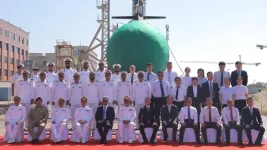- Views: 2K
- Replies: 23
The strategic balance of power in the Indian Ocean Region (IOR) is facing a potential shift as Pakistan intensifies its efforts to acquire a nuclear-powered ballistic missile submarine (SSBN), a move that could significantly escalate regional tensions and challenge established international non-proliferation norms. This development follows India's recent launch of its third SSBN earlier this year, marking a significant step in its own nuclear deterrence capabilities.
Driven by the need to establish a credible second-strike nuclear capability, mirroring India's strategic posture, Pakistan has been actively engaging with China, its long-standing ally, to procure an SSBN. Islamabad's demands are ambitious: not only does it seek a "friendly price," but it also insists that the submarine be operated by a Pakistani crew and that operational costs be covered by China.
China, however, finds itself in a precarious position. Transferring or leasing an SSBN to Pakistan would directly contravene its own stated non-proliferation policies and violate international commitments, specifically the principles outlined in the Treaty on the Non-Proliferation of Nuclear Weapons (NPT), of which China is a signatory. The NPT aims to prevent the spread of nuclear weapons and weapons technology, and such a transfer could be interpreted as a direct violation.
As an alternative, China has offered Pakistan eight Hangor-class conventional submarines, capable of carrying tactical nuclear warheads on sub-sonic cruise missiles. However, the Pakistani Navy remains unsatisfied, seeking the greater deterrent power afforded by submarine-launched ballistic missiles (SLBMs). The current Hangor-class submarines are not equipped with the Vertical Launch Systems (VLS) necessary to deploy SLBMs, prompting Pakistan to demand either modifications to incorporate VLS or the transfer of older Chinese SSBNs like the Type 092 (Xia-class).
The Type 092, a first-generation SSBN, was the first nuclear-powered submarine designed and built in Asia but is considered obsolete compared to China's more advanced Type 094 (Jin-class) SSBNs. Publicly available information indicates the sole Type 092 has likely been significantly modified or is perhaps even decommissioned, raising questions about its operational viability. The People's Liberation Army Navy (PLAN) never considered the Type 092 a success.
China's reluctance is understandable. While Beijing seeks to expand its influence in the IOR and bolster its strategic partnership with Islamabad, supporting Pakistan's nuclear submarine ambitions could severely damage its international standing, jeopardize relations with other global powers, and set a dangerous precedent in the global nuclear order. It is also likely that the United States and India would apply pressure to dissuade Beijing from acceding to Islamabad's request.
Further complicating the situation, Pakistan has shown interest in North Korean SLBM technology. This suggests a broader Pakistani strategy to diversify its sources of military technology and potentially circumvent the stricter controls imposed by China or international bodies.
North Korea, known for its own nuclear and missile programs, operates outside of the NPT framework, potentially making it a more willing partner for Pakistan's nuclear ambitions. While North Korea has made significant progress in developing SLBMs, as evidenced by the Pukkuksong series, it primarily fields diesel-electric ballistic missile submarines (SSBs), notably the Sinpo-class.
Although, in September 2023, North Korea revealed its first nuclear attack submarine, the Hero Kim Kun Ok, described as being capable of carrying tactical nuclear weapons. Questions remain about the sub's capabilities and whether it carries VLS for SLBMs.
The current scenario presents a complex challenge for China, requiring it to carefully balance its strategic interests with its international obligations and the potential repercussions of its actions. The outcome of these negotiations could have far-reaching consequences for the security dynamics of the IOR and the global non-proliferation regime.
Whether Pakistan succeeds in its quest for an SSBN remains to be seen, but its pursuit highlights the evolving nature of nuclear deterrence and the increasing complexity of regional security in the 21st century.



